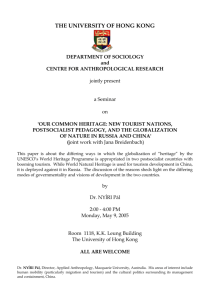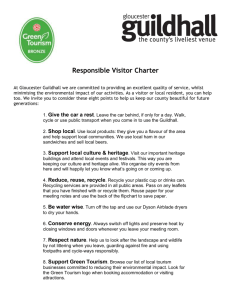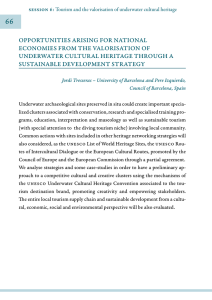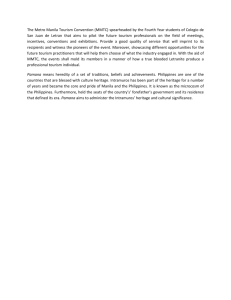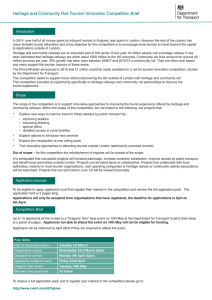Industrial Heritage Tourism: Landscapes of Nostalgia
advertisement
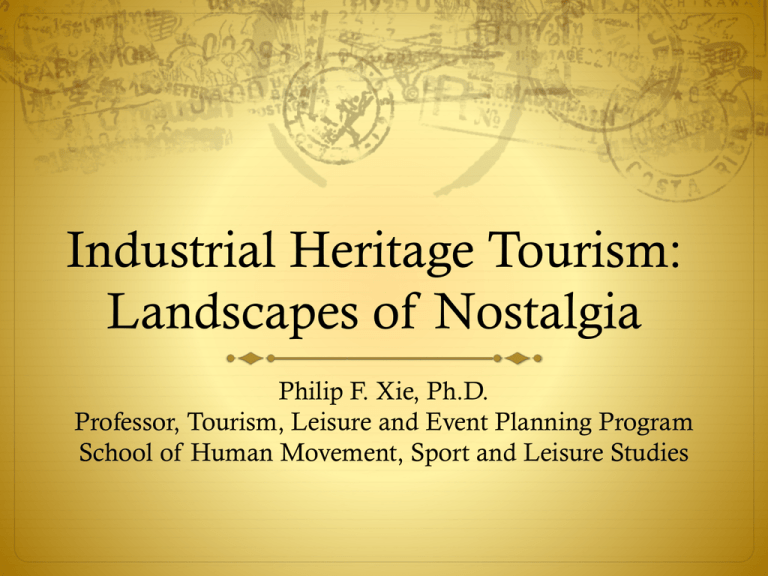
Industrial Heritage Tourism: Landscapes of Nostalgia Philip F. Xie, Ph.D. Professor, Tourism, Leisure and Event Planning Program School of Human Movement, Sport and Leisure Studies Detropia: Ruin Porn Industrial Past Landscapes of Nostalgia Les Lieux de Mémoire (Sites of Memory) The industrial landscape Industrial remains, ruins, warehouses, factories, etc. New space for resourceful reinterpretation New “tourist gaze” directs at industrial heritage sites Third Industrial Revolution Industrial Heritage Tourism The Ironbridge Gorge Museum in UK (birthplace of Industrial Revolution) Tate Modern, London (former Bankside power station) The Distillery District in Toronto, Canada The movement of Kojo Moe in Japan (factory love) Museum of the Automobile (Museo dell'Automobile) in Italy BMW European program Commodification of Industrial Heritage Presentation Demonstrate how industrial heritage tourism can be theorized from historical, cultural, social and economic perspectives Present case studies of industrial heritage tourism sites and compare the differences and approaches by countries in North America, Asia and Australasia Make suggestions about the future of industrial heritage tourism research and development Theorizing Heritage: Landscape, Memory and Identity Heritage is a transposable concept that is often disputed, yet dispute creates heritage (Cassia, 1999: 254) Tangible and intangible heritage Rubbish theory (Thompson, 1979) The value of an object is rising and falling depending upon context as it ages Perceived scarcity or other changes of valuation cause prices to rise as the object ages Vintage automobiles, typewriters, and other industrial products Undesirable Heritage Grotesque heritage (industrial heritage in the Soviet era) Prescriptive forgetting (the concentration camps and forced labor were used to manufacture automobiles during World War II in Germany) Repressive erasure (Communist-era military bunkers in Eastern Europe) Nostalgia Misrecognition of the past Temporal distortion Postmodern imagination Industrial heritage is subject to the kind of dehistoricizing and romanticizing imagery that “characterizes nostalgic treatments of more distant but nonetheless passing ways of life” (Strangleman, 2011) Nostalgic consumer – contemporary “spelunker” Although nostalgia plays a key role in the revival of cultural heritage, it is inherently inauthentic, mainly because it uses memory that is highly unstable and unique to visitor (Hodge, 2011) History of Industrial Heritage Tourism The introduction of World’s Fairs in the late 19th century The Crystal Palace in 1851 Chicago’s Columbian Exposition of 1893 Le tourisme industriel (Industry Quebec, 1982) Industrietourismus (Soyez, 1986) The Industrial Heritage: Managing Resources and Uses (Alfrey & Putnam, 1992) Definitions of Industrial Heritage Tourism Industrial tourism, factory tourism, factory visits, company tours, industrial archeology Industrial heritage presents and preserves the historical, technological, social, scientific and architectural values of industrial traditions Revitalize Rustbelts Improve region’s image Counteract public prejudice Enhance economic development Raise tourist profile of cities and regions Definition The vicissitude of industrial transformation in recent decades are too rapid, ephemeral and apt to vacillate operating and non-operating to distinguish between industry and industrial heritage Transform industrial heritage to the core attraction of tourism and revalue/modify the essence of industrial heritage to create the passage of experiencing the traditions and to satisfy the recreational needs of tourists Industrial sites, both functional and no longer functional, partake in tourism by offering the kind of coherent and commodifiable image that is necessary to produce the tourist experience Challenges of Industrial Heritage Tourism Lack of public awareness Lack of economic measures Spatial and regional complexities Conceptual Framework The Process of Industrial Heritage Tourism Conservation Potentials Industrial triage Assess the characteristics of the industrial areas Stakeholders Business leaders, planners, sponsors, etc. Space Adaptive Reuse Recycle for new uses and tourist attractions Community Economics Take advantage of historical character, ambience and sense of place Creative economy Authenticity Opposite of generic Genius loci Images Perceptions A common community perception Proposed Jeep Museum, Toledo, Ohio Willys-Overland: first Jeep in the world The most prosperous city in 1960s Daimler-Chrysler AG “A smile that is missing a lot of teeth” Proposed National Jeep Museum Urban regeneration City image Economics Methodology In-depth interview: Stakeholders in different fields The examination of historical documents Telephone interviews Results Huge potentials and conflicted views from stakeholders Controversial reuse and ill-informed economic impact Slippery authenticity and poor perception Huge potentials and conflicted views from stakeholders The potential costs and benefits for the community The need of strong support from Chrysler The authentic preparation for the museum Local participation Controversial reuse and ill-informed economic impact The building of museum for conservation and interpretation The manipulation of the urban landscape to satisfy visitors’ expectation A weak private-public partnership Slippery authenticity and poor perception The authentic location The commodification of Jeep Poor community perception Research Implications Increase public awareness Strong government support Encourage public-private partnership Salt Heritage Tourism Salt Tourism in Taiwan Southwestern region in Taiwan was once dominated by the salt industry The significance of the salt production economy to locals’ livelihood formed the cultural landscape The solar evaporation method Renovation Scheme Themes Production process: the solar evaporation method Products: flaky sea salt used for souvenirs Programs Participatory experience Interpretative assistance Designs Modern design Nostalgic style Methodology The experiments was undertaken in the Dongsan Rest Area along the highway Respondents were randomly assigned to one of experimental groups Respondents were asked to fill out the questionnaire regarding perceived experience in themes, programs, and designs, perceived attractiveness and socio-demographics 440 respondents participated and 412 were valid Findings Participatory experience was ranked highest. It provides fun and memorable experience for tourists Both nostalgic and modern décor perceived as major attractions for salt tourism Tourists want certain aspects of experiences to signal traditionalism, while they like souvenir products to be rather modern Rail Tourism Railroads are a huge part of the State’s tourism niche and accounts for about 6% of the tourism dollars in the State. Rail tourism includes short train rides, railroad park observations, museum visitations, special events, such as rail fairs, festivals and days Rail tourism provides potential economic benefits for these towns as a means of business and heritage identity Problems Little research has been done to examine the profiles of rail enthusiasts; Economic impacts of rail tourism on the local communities have been ignored; Many towns neglect the potentials of using railroads as a tourism resource to revive the economy. Research Objectives Identify the problems and prospects of rail tourism; Economic impact of rail tourism in relation to substantial economic expenditures Understand the profile of rail tourists Rail Tourism Attractions Scenic railroads and the railroad observation parks: These are the most popular sites that attract rail tourists and enthusiasts and generate the most visible benefits for the communities. The examples are and Jefferson Depot; Railway organizations for travel and tourism: By serving as Destination Marketing Organizations (DMOs), these groups raise the awareness of rail tourism and promote destination travel. Well-known organizations for rail tourism include Cuyahoga Valley scenic railroad and Midwest Railway Preservation Society in Cleveland; Rail excursions companies: These companies provide tourism opportunities for individuals interested in rail tourism with short rides to selected destinations. Examples of rail excursion companies are Ashtabula’s Carson & Jefferson railway; and Railway museums: These sites provide representations of community culture and heritage relating to railroads. Among the museums that we will visit are the Toledo, Lake Erie and Western Railway and Museum located in Waterville and Conneaut Historical Railroad Museum. Case Study Ohio has the highest number of public highway crossings of train tracks in the US due to its flat geography; Everyone in Ohio is approximately within 10 miles of a railroad track Deshler, Ohio, was ranked as one of top ten towns for rail enthusiasts according to Wall Street Journal (May 19, 2007). The town caters to rail nostalgia with a city park at the diamond-shaped crossing of two busy CSX Railroad tracks with picnic facilities and a speaker to broadcast the track controllers’ conversations. Methodology Survey railway infrastructure in Deschler. The infrastructure encompasses a variety of facilities and amenities to attract tourists, such as the quality of the railway, the availability of observation areas, the quality of museums and the nearby hotels and restaurants; Conduct interviews with rail enthusiasts to gauge their demographics and expenditures of travels so that we can gauge the potential economic benefits for the site and the local communities. Findings Poor perception of using railway for tourism Rail enthusiasts: 35 to 55 years old, average educational attainment, males, $35,000 to $55,000 annual income Interests in rail were brought up by the influence of families and friends Nostalgia Selective memories Constructive suggestions for future improvement Research Implications Niche market in the US Marketing and promotion Word of mouth Revitalization of railway Understanding the profile of rail enthusiasts Waterfront Redevelopment In recent decades, numerous waterfronts have undergone a reorientation from brownfields to commercial, residential and recreational areas. Docklands in London, UK The Baltimore waterfront in the US The Tokyo Waterfront City, Odaiba in Japan The riverfront development in Thailand and Singapore Auckland, New Zealand The Scope of Auckland Waterfront Problems Lack of morphological analysis The relationship with tourism development Public participation Socioeconomic impacts of the waterfront redevelopment Heritage Components Industrial heritage Maritime heritage City of sails The America’s Cup World Rugby Cup Methodology Reviews of documents Fieldworks Maps Morphological process of the waterfront The Commercial Waterfront c. 1950 C en Commercial Point Bay Britomart Point Stanley Freemans Bay Waitemata Harbour tral Wh arf N or ther nW K in gs W harf harf rf ha Wh arf W Q ue The W n ter es Prin ces W ha rf Waitemata Harbour ens Wh arf 1866 rf ha W rt po Ex Official Bay Auckland Railway Station Yard Mechanics Bay Albert Barracks Albert Park tain C oo kW Ma harf rsde nW harf K in gs W harf ens W Q ue Waitemata Harbour C ap Prin ces Wh arf St W re ha et rf W ha rf yn ya r y d sa al W H Q uee ns W harf Waitemata Harbour harf Late twentieth century 1895 Freemans Bay Mechanics Bay Albert Park Albert Park 1925 N Wh arf ther n Wh K in gs W arf harf Waitemata Harbour 0 250 500 m N or C en tral ens Wh arf Q ue W Wh arf rn Prin ces W te es rf ha Land reclamation Auckland Railway Station Yard Albert Park Foreshore line in 1841 Working Port Initial Stages of Redevelopment Commercial Recreation Wynyard Quarter Combination of Governmental Intervention and Developer Mixed-Used Approach Research Implications Directing morphology toward understanding the physical and socioeconomic impacts of major factors, which have influenced the revitalization of the waterfront in Auckland Governance structures The process has inevitably diluted the significance of industrial heritage and maritime histories, and created a new meaning: redevelopment becomes a commodity traded by governments and estate developers The Wynyard Quarter Conclusions Living industrial heritage for tourism Partnership toward a common goal The production of mixed-use spaces Understanding tourist segmentations The growth of industrial heritage tourism as an academic discipline Terrain Vague the Spanish architect, Ignasi de SolàMorales, coins the term terrain vague in French, industrial heritage tourism constantly serves to remind people of the ways in which “the memory of the past seems to predominate over the present”.
